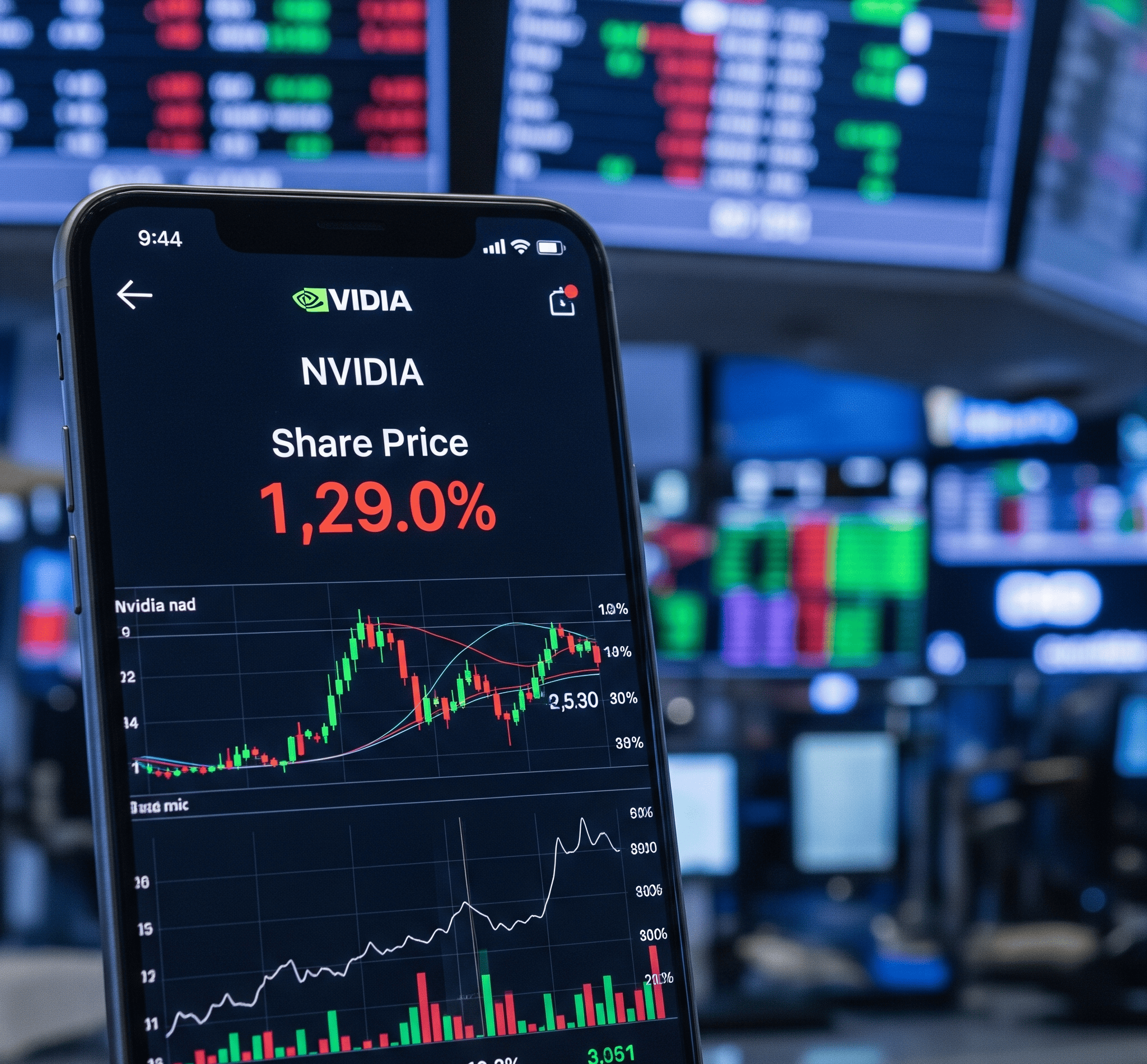Nvidia's Trillion-Dollar Question: Will AI Catapult NVIDIA to Unprecedented Gains in the Next 5 Years?
Nvidia (NASDAQ: NVDA) has experienced an astonishing surge, with its shares climbing over 750% in less than three years, catapulting its market capitalization into the trillions. This meteoric rise, undeniably fueled by the burgeoning artificial intelligence (AI) megatrend ignited by OpenAI's ChatGPT, has left many investors with a critical question: Can Nvidia's shares sustain this momentum, or has the AI boom already priced in its future glory?
At Finance Monthly, a respected voice in global financial analysis, our team of seasoned financial analysts and market strategists, drawing on decades of collective experience observing and interpreting market trends, has undertaken a rigorous examination of Nvidia's prospects. This article synthesizes the predictions of five prominent experts and combines them with our comprehensive market insights to project Nvidia's trajectory over the next five years. Our analysis suggests that while the path ahead may present its share of market volatility, Nvidia's foundational role in the AI revolution positions it for continued, substantial growth.
Table of Contents
Nvidia's Current Market Position
Expert Predictions for Nvidia's Future
Driving Factors for Growth
Potential Headwinds
Finance Monthly's Outcome
Finance Monthly's Stock Prediction
Nvidia's Unrivaled Position in a Trillion-Dollar Market
As of July 11, 2025, Nvidia’s stock trades at approximately US$164.10, commanding a staggering $4.0 trillion market capitalization. This impressive valuation is a testament to the company's unrivaled leadership in the GPU market, where it reportedly holds an astonishing 88% market share as of Q1 2024.
Nvidia's recent financial performance further underscores its robust health and market dominance. In the first quarter of fiscal year 2025, the company reported $26 billion in sales, marking an explosive 262% increase compared to the prior-year quarter. Non-GAAP diluted earnings per share (EPS) soared by an even more impressive 461% to $6.12. These figures, readily available in Nvidia's public filings, solidify its current standing as a powerhouse poised to capitalize on the unfolding AI era.
What Leading Experts Forecast for Nvidia's Future
Finance Monthly has meticulously reviewed the projections of several influential financial minds to provide a multi-faceted view of Nvidia's potential. These insights are crucial for understanding the broader market sentiment and the specific drivers behind their optimistic outlooks:
- Philippe Laffont (Coatue Management): Billionaire hedge fund manager Philippe Laffont's firm, Coatue Management, known for its deep dives into technological disruption and a track record of identifying high-growth opportunities, is remarkably bullish. Their 2025 East Meets West (EMW) presentation forecasts Nvidia reaching a market capitalization of $5.6 trillion by 2030. This projection, implying nearly a 60% upside from current levels or approximately 12% annual gains, underscores Laffont's belief in Nvidia's foundational and enduring role in the AI infrastructure build-out.
- ARK Invest: Cathie Wood's ARK Invest, famed for its focus on disruptive innovation and long-term exponential growth themes, holds a very optimistic outlook for Nvidia. While specific 2029 price targets for Nvidia aren't frequently updated in recent public statements, ARK Invest's consistent high conviction in AI and related technologies suggests they anticipate substantial, potentially multi-fold, gains. Their investment philosophy prioritises companies at the forefront of technological paradigm shifts, a category Nvidia clearly embodies.
- 24/7 Wall St.: This widely-read financial news and opinion publication provides a tangible target, projecting NVDA could hit $241.23 by the end of 2030. This represents a solid 52% gain over five years from some earlier reported current price levels, reflecting a more measured yet confident growth trajectory based on their fundamental analysis of market demand and competitive landscape.
- Jim Cramer: The influential financial commentator Jim Cramer, known for his strong market convictions and ability to interpret market sentiment for a broad audience, has expressed unwavering confidence in Nvidia's continued growth. His assertion that a "$4 trillion stock market value is just the start for Nvidia" aligns with a perspective that views the current AI revolution as a generational shift, with Nvidia at its epicentre, far from its peak.
- Loop Capital: Analysts from investment firm Loop Capital, known for their rigorous industry research and granular market assessments, have presented an aggressive estimate, projecting Nvidia could achieve a $6 trillion market cap by 2028. Ananda Baruah and Alek Valero from Loop Capital highlight Nvidia's "essentially a monopoly for critical tech" in the nascent AI sector as the primary driver for such rapid value appreciation, a viewpoint supported by the demand for their specialized hardware.
The Irresistible Tailwinds: Why Nvidia is Primed for Sustained Growth
Finance Monthly's in-depth analysis identifies several powerful and interconnected trends that underpin these optimistic forecasts, positioning Nvidia for continued, robust expansion:
- Explosive AI Infrastructure Spending: The scale of investment into AI is simply unprecedented. Management consulting firm McKinsey & Company recently projected global AI infrastructure spending to reach a colossal $6.7 trillion by 2030. Furthermore, The International Data Corporation (IDC) forecasts global spending on AI infrastructure to surpass $200 billion by 2028. Within this, the AI chip market alone is expected to be worth $311 billion by 2029 (MarketsandMarkets), with even more bullish estimates from competitors like AMD, who see the market hitting $400 billion by 2027. As the undisputed leader in AI chip design and integrated platforms like CUDA, Nvidia is uniquely positioned to be the primary beneficiary of this massive wave of capital allocation.
- Project Stargate – A Monumental Partnership: The ambitious $500 billion AI infrastructure initiative in the U.S. through 2029, known as "Project Stargate," involves industry titans like Oracle, OpenAI, and SoftBank. Nvidia's direct and crucial partnership in this venture, as confirmed by public reports, secures its pivotal role in building the backbone of America's AI capabilities, ensuring long-term demand for its cutting-edge solutions.
- Relentless Innovation and Enduring Market Dominance: Nvidia's enduring success is rooted in its profound history of innovation. From inventing the GPU to CEO Jensen Huang's visionary foresight into AI's transformative potential a decade ago, the company has consistently stayed ahead of the curve. The highly anticipated Blackwell platform, despite a rumored minor delay, is poised to be a game-changer, promising significant advancements in energy efficiency and performance for AI development. This continuous cycle of innovation is critical for maintaining its formidable competitive moat and superior pricing power.
- Diversified High-Growth Market Opportunities: While AI data centres are the immediate and most potent growth engine, Nvidia's strategic reach extends into other lucrative sectors. Its historical gaming segment is experiencing a resurgence, with AI-driven graphics and technologies like DLSS (Deep Learning Super Sampling) promising enhanced user experiences. Furthermore, the burgeoning field of digital-twin technology—creating virtual replicas of physical systems for simulation and optimisation across industries—represents a massive, largely untapped market, with Nvidia Omniverse and its AI platforms at the forefront of this emerging industry.
Navigating the Headwinds: Challenges on the Horizon
Despite the overwhelmingly positive outlook, Finance Monthly’s comprehensive analysis also considers the potential challenges and risks that Nvidia must navigate:
- Intensifying Competition and In-House Chip Development: While Nvidia currently enjoys a dominant market position, the landscape is becoming increasingly competitive. Rivals like Advanced Micro Devices (AMD) and Intel are heavily investing in their AI chip offerings, with AMD's MI350 series showing performance on par with Nvidia's Blackwell GPUs, according to some analysts. Moreover, some of Nvidia's largest cloud and AI customers, including Amazon, Microsoft, Alphabet, and Meta Platforms, are strategically developing their own custom AI silicon. While this doesn't spell immediate disaster, it could lead to a gradual reduction in their reliance on Nvidia for certain workloads over the long term, impacting future revenue streams from these hyperscalers.
- Geopolitical and Regulatory Pressures: The ongoing technological rivalry between the United States and China, particularly export restrictions on high-performance chips, continues to affect Nvidia's revenue from the historically significant Chinese market. Although Nvidia is actively mitigating this by fostering new relationships in other geographies, notably the Middle East, geopolitical tensions and evolving regulatory frameworks remain a notable source of uncertainty that could impact revenue streams and supply chain stability.
- Market Volatility and Innovation Risks: As a high-growth technology stock, Nvidia is inherently susceptible to broader market volatility and shifts in investor sentiment. The AI sector, while revolutionary, is still rapidly evolving. The inherent uncertainties of cutting-edge innovation mean there is always a risk of unforeseen technological breakthroughs from competitors, or even product development challenges within Nvidia itself, such as the rumoured minor delay for the Blackwell platform. A rapid deceleration in enterprise AI adoption could also temper growth expectations.
Finance Monthly's Outcome: Nvidia Poised for a New Chapter of Growth
After rigorously analysing expert forecasts, market dynamics, and Nvidia's strategic positioning through our meticulous analytical framework, Finance Monthly is confident that Nvidia is exceptionally well-positioned for substantial, continued growth over the next five years.
The company's foundational technology, its undisputed leadership in the rapidly expanding AI sector, and its robust financial health collectively present a compelling investment thesis. While short-term market fluctuations, competitive advancements, or geopolitical shifts may introduce periods of volatility, and we acknowledge the inherent unpredictability of a rapidly evolving sector, the powerful secular tailwinds driving AI adoption globally are expected to significantly outweigh these challenges. Finance Monthly believes Nvidia will continue to be a dominant force, potentially doubling its value again in the coming years as the AI revolution truly takes hold.
Finance Monthly's Nvidia Share Price Prediction: Next Five Years
Based on our detailed analysis and synthesis of expert consensus, Finance Monthly has formulated its own projection for Nvidia's share price over the next five years.
This forecast is built on a compounded annual growth rate (CAGR) of approximately 16.5%, which our analysts derived by averaging key market capitalization projections from leading firms and carefully considering Nvidia's historical growth patterns, product roadmap, and future market opportunities. This comprehensive approach provides a balanced perspective, factoring in both aggressive growth potential and inherent market variables.
Based on our detailed analysis and synthesis of expert consensus, Finance Monthly has formulated its own projection for Nvidia's share price over the next five years. This forecast is built on a compounded annual growth rate (CAGR) of approximately 16.5%, which our analysts derived by averaging key market capitalization projections from leading firms and carefully considering Nvidia's historical growth patterns, product roadmap, and future market opportunities. This comprehensive approach provides a balanced perspective, factoring in both aggressive growth potential and inherent market variables.
Current Price (as of July 11, 2025): US$164.10
| Year (End of July) | Predicted Share Price (US$) | Yearly Gain (%) |
|---|---|---|
| 2025 | $164.10 | N/A |
| 2026 | $191.13 | 16.47% |
| 2027 | $222.69 | 16.51% |
| 2028 | $259.46 | 16.51% |
| 2029 | $302.26 | 16.49% |
| 2030 | $352.19 | 16.52% |
Frequently Asked Questions (FAQs)
What are the main drivers of Nvidia's growth?
Nvidia's growth is primarily driven by the explosive demand for AI infrastructure, fueled by the burgeoning artificial intelligence megatrend. Key factors include:
- Massive AI Infrastructure Spending: Projections from firms like McKinsey & Company (up to $6.7 trillion by 2030) and IDC (over $200 billion by 2028 for AI infrastructure spending) indicate a colossal market, with Nvidia's GPUs being central to this build-out.
- Strategic Partnerships: Significant initiatives like the $500 billion "Project Stargate" in the U.S., involving Oracle, OpenAI, and SoftBank, directly secure Nvidia's role in developing core AI capabilities.
- Relentless Innovation: Nvidia's continuous innovation, from its invention of the GPU to upcoming platforms like Blackwell, ensures its technological leadership and competitive moat.
- Diversified High-Growth Opportunities: Beyond data centers, Nvidia benefits from growth in gaming (enhanced by AI), professional visualization, and emerging markets like digital-twin technology (Omniverse) and automotive AI.
How does Nvidia compare to its key competitors in the AI chip market?
Nvidia currently holds a dominant position in the discrete GPU market, with an estimated 88% market share as of Q1 2024. Its primary competitors are Advanced Micro Devices (AMD) and Intel. While both AMD (with its MI350 series) and Intel are heavily investing in AI chip development and showing increasing capabilities, Nvidia maintains its lead due to:
- Performance Leadership: Its GPUs are consistently at the forefront of AI training and inference.
- Software Ecosystem (CUDA): Nvidia's CUDA platform provides a mature and widely adopted software ecosystem that is critical for AI developers, creating a strong barrier to entry for competitors.
- Integrated Solutions: Nvidia offers comprehensive hardware and software solutions (like DGX SuperPODs) that simplify AI deployment for large enterprises and cloud providers.
- In-house Chip Development by Hyperscalers: Major cloud and AI customers like Amazon, Microsoft, Alphabet, and Meta Platforms are also developing their own custom AI silicon. While this poses a long-term competitive challenge, it currently supplements, rather than replaces, their reliance on Nvidia for the most demanding AI workloads.
What are the primary risks associated with investing in Nvidia?
While Nvidia's outlook is strong, investors should be aware of several risks:
- Intensifying Competition: Increased competition from AMD and Intel, alongside the development of in-house AI chips by major customers, could erode Nvidia's market share over time.
- Geopolitical and Regulatory Pressures: Export restrictions, particularly concerning the Chinese market, have impacted and could continue to impact Nvidia's revenue. Shifting global trade policies create uncertainty.
- Market Volatility and Innovation Risks: As a high-growth tech stock, Nvidia's shares are susceptible to broader market downturns. The rapid pace of innovation in AI also means a constant need to stay ahead, with risks of unforeseen technological breakthroughs by rivals or delays in Nvidia's own product roadmap (e.g., potential minor delays for Blackwell).
How do geopolitical factors and international market shifts impact Nvidia's business and stock?
Geopolitical factors, particularly the U.S.-China technology rivalry and associated export controls, have a significant impact on Nvidia. Historically, China was a major market for Nvidia's high-performance chips. Current restrictions mean Nvidia faces limitations on selling its most advanced AI GPUs into China, impacting revenue from that region.
To mitigate this, Nvidia is actively diversifying its revenue streams by fostering new relationships in other international markets, such as the Middle East. However, ongoing geopolitical tensions and the potential for new or stricter regulations worldwide remain a notable source of uncertainty that could affect Nvidia's global sales strategies, supply chain, and overall revenue mix, thus influencing investor sentiment and stock performance.
What is Finance Monthly's outlook for Nvidia's stock performance over the next five years?
Finance Monthly holds a confident and positive outlook for Nvidia's stock over the next five years. Based on our detailed analysis and synthesis of expert consensus, we project a compounded annual growth rate (CAGR) of approximately 16.5% for Nvidia's share price through 2030.
This growth is expected to be driven by Nvidia's foundational role in the rapidly expanding AI infrastructure market, its continuous innovation, and its strategic positioning across various high-growth sectors. While market volatility and competitive pressures are anticipated, the powerful secular tailwinds of AI adoption are expected to substantially outweigh these challenges. Our analysis suggests Nvidia is poised for significant continued growth, potentially doubling its value again in the coming years.
General Disclaimer & Important Notice:
This article, including all analyses, predictions, forecasts, and opinions, is provided by Finance Monthly for informational and educational purposes only and is intended to be a general discussion of market trends and expert viewpoints. It is not financial advice and should not be construed as a recommendation to buy, sell, or hold any securities, including Nvidia (NVDA) stock, or to engage in any investment strategy.
No Guarantee of Performance: Past financial performance is not indicative of future results. Investing in the stock market involves substantial risk, including the possible loss of principal. The value of investments can fluctuate significantly due to market volatility, economic conditions, industry-specific factors, and company-specific events.
Forward-Looking Statements: This article may contain forward-looking statements, predictions, and projections. These statements are based on current expectations, assumptions, and beliefs and are subject to risks and uncertainties that could cause actual results to differ materially from those described. Finance Monthly makes no representations or warranties regarding the accuracy or completeness of these statements.
Independent Research: The information presented is based on our analysis of publicly available data, expert opinions, and market research. While Finance Monthly strives for accuracy and reliability, we do not guarantee the completeness or correctness of the information contained herein. Market conditions, expert views, and company performance can change rapidly.
Personal Responsibility & Professional Advice: Investment decisions should always be made based on your own thorough research, financial situation, risk tolerance, and investment objectives. Before making any investment decisions, you should consult with a qualified and licensed financial advisor, tax professional, or legal counsel. Do not rely solely on the information provided in this article.
No Liability: Finance Monthly, its authors, editors, and affiliates shall not be liable for any direct, indirect, incidental, consequential, or punitive damages arising out of your access to, use of, or reliance on any content in this article.
By accessing and reading this article, you acknowledge and agree to this disclaimer.















